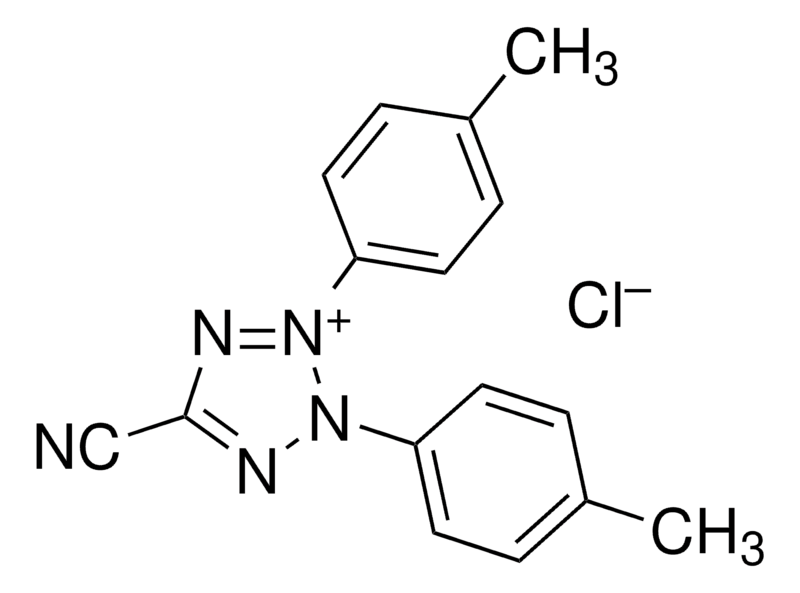Sigma-Aldrich 5-Cyano-2,3-di-(p-tolyl)tetrazolium chloride ≥85% (HPLC)
Catalog No :
CAS Number :
Brand :
In Stock
Specifications:
| Application | Colorimetric Assay | ||
| Storage Temperature | 2-8°C | ||
| Product Type | Laboratory Chemical | Forms | Powder |
| Product Brand | Sigma-Aldrich | ||
| Product Grade | Analytical grade | Formula | C₁₆H₁₄N₅·Cl |
Sigma-Aldrich® 5-Cyano-2,3-di-(p-tolyl)tetrazolium chloride, commonly known as CTC, is a premium-grade, highly sensitive tetrazolium salt widely utilized as a biochemical reagent and viability indicator. With a purity level ≥85% confirmed by High-Performance Liquid Chromatography (HPLC), CTC offers reliable, consistent, and accurate results for diverse microbial, cellular, biochemical, and environmental research applications.
Chemical Identity and Specifications
- Chemical Name: 5-Cyano-2,3-di-(p-tolyl)tetrazolium chloride
- Common Abbreviation: CTC
- CAS Number: 90217-02-0
- Purity Level: ≥85% (verified by HPLC)
- Molecular Formula: C16H13ClN5
- Molecular Weight: 308.76 g/mol
- Appearance: Pale yellow to orange crystalline powder
- Solubility: Moderately soluble in water and aqueous buffer solutions; readily soluble in organic solvents (ethanol, methanol, DMSO).
Principle and Mechanism of Action
CTC serves as a fluorescent tetrazolium salt, uniquely capable of assessing cellular metabolic activity through reduction to a fluorescent, red fluorescent formazan precipitate (CTF, or 5-cyano-2,3-di-(p-tolyl)formazan). Active microbial or cellular respiratory enzymes, especially those within electron transport chains, enzymatically reduce CTC to the highly fluorescent CTF.
This fluorescence directly correlates with metabolic and respiratory activity, allowing precise qualitative and quantitative assessments of active, viable, or respiring microorganisms and cells.
Applications and Detailed Use Cases
1. Microbial Viability and Respiration Assays
Primary Use:
- Accurate and rapid detection of viable and metabolically active bacteria, fungi, and protozoa in various microbiological assays.
Practical Example:
- Microbial ecologists studying aquatic ecosystems use CTC to determine viable microbial populations. Active bacteria metabolically reduce CTC, producing fluorescent formazan deposits that allow precise enumeration and differentiation between live and dead microbial communities.
2. Flow Cytometry and Fluorescence Microscopy Studies
Primary Use:
- Identification, quantification, and sorting of actively respiring microorganisms or cells by flow cytometry or fluorescence microscopy.
Practical Example:
- Researchers perform flow cytometric analysis of environmental or clinical samples incubated with CTC to rapidly distinguish metabolically active cells. This approach enables high-throughput screening, sorting, and quantification of viable versus non-viable populations in complex mixtures.
3. Environmental Microbiology and Water Quality Testing
Primary Use:
- Assessment of microbial metabolic activity and viability in water, soil, sediment, and wastewater samples for environmental monitoring and ecological studies.
Practical Example:
- Environmental scientists utilize CTC staining to assess microbial respiration in contaminated water or sediment samples. The fluorescent CTC assay identifies actively respiring organisms, providing valuable information about ecosystem health, biodegradation processes, and remediation efficiency.
4. Antimicrobial Efficacy and Biocide Testing
Primary Use:
- Rapid evaluation of antimicrobial agents' effectiveness against bacteria, fungi, and biofilms.
Practical Example:
- Industrial microbiologists testing disinfectants incubate target microorganisms or biofilms with antimicrobial compounds followed by CTC staining. Reduction in fluorescent formazan production indicates microbial inactivation, enabling rapid, quantitative assessments of biocide performance.
5. Biofilm Activity and Formation Studies
Primary Use:
- Detection and quantification of biofilm viability, metabolic activity, and antimicrobial susceptibility on various surfaces or materials.
Practical Example:
- Medical device researchers examining biofilm formation on implants incubate bacterial biofilms with CTC to visualize active microbial respiration. Fluorescent microscopy clearly reveals active biofilm presence, density, and viability, facilitating materials selection and antimicrobial evaluations.
Advantages and Key Benefits
- High Sensitivity: Fluorescent output provides superior detection sensitivity compared to traditional colorimetric assays.
- Rapid and Reliable: Offers rapid, accurate quantification of viability and respiration in complex biological samples.
- Quantitative and Qualitative: Compatible with both microscopy-based visual assessment and flow cytometric quantitative analysis.
- Proven Purity (≥85% HPLC): Ensures reproducible, consistent experimental results in critical applications.
Storage and Stability
- Store refrigerated at 2–8°C, away from direct light and moisture.
- Maintain tightly sealed containers to prevent degradation and ensure long-term reagent stability.
- Follow standard laboratory safety practices for chemical handling.
Intended Users
- Microbiology and environmental research laboratories
- Biotechnology and pharmaceutical research groups
- Industrial and clinical laboratories performing antimicrobial testing
- Flow cytometry and fluorescence microscopy specialists
- Academic and governmental institutions studying microbial ecology and environmental health
Sigma-Aldrich® 5-Cyano-2,3-di-(p-tolyl)tetrazolium chloride (CTC) ≥85% (HPLC) is an essential reagent for accurate, sensitive, and rapid assessment of microbial and cellular metabolic activity. Its reliability, versatility, and superior performance make it indispensable for advanced microbiological, ecological, biochemical, and environmental research applications.
- Pack Size: 10mg 50mg




 0
0
